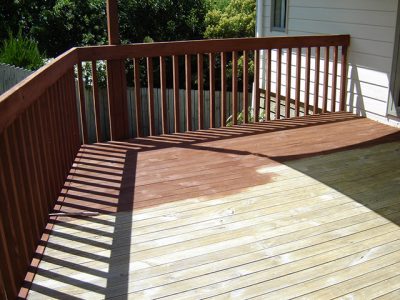Easy-To-Follow Simple Steps in Staining Your Deck
A deck is like an outdoor room, which is a perfect place to relax or entertain. However, since decks are highly exposed to numerous elements and foot traffic, they need maintenance from time to time to keep them protected. Staining of decks well assures one of additional barbecue years.
 These simple steps will guide you and teach you how to stain decks and avoid unexpected happenings. With these easy-to-follow steps, you will also end up with a professional-looking deck that you will be proud.
These simple steps will guide you and teach you how to stain decks and avoid unexpected happenings. With these easy-to-follow steps, you will also end up with a professional-looking deck that you will be proud.
Prepare the surface of the deck
Ensure the wood is dry and free of contaminants beforehand. Paint applied to damp or wet surfaces easily peel because of not adhering well to the surface.
A clean surface is equally important. The area need be free of dirt, mildew stains and any other forms of contaminants that would risk the whole process. Use an ideal cleaning agent to clean the surface and rinse with water before allowing it to dry for a few days.
A few ideas to note before you begin staining your deck.
- Avoid the application of stain of direct sunlight.
- In case, there is the likelihood of it raining anytime within the next twelve to twenty-four hours.
- Before you paint the whole deck, test a small unnoticeable area just to be sure of the outcome.
- If you want to paint a large surface requiring different gallons of paint, mix all paint in one container to ensure there is consistency all through.
Selecting the right stain
There is a broad range of stain and paints to choose from, and below is an overview of some that you could choose.
Clear stain and wood toned: these stains are lightly toned and bright, thus near transparent. Therefore, they allow for the visibility of texture and wood grain.
Semi-transparent: with this pigment, you are likely to see more color on the surface as compared to wood toner stains remain partly visible.
Semi-solid stains: semi-opaque or otherwise semi-solid stains covers most of the wood. However, it allows for some of the texture on the wood to remain visible.
Solid: if you want to hide your wood completely, this is the best finish to choose. With this finish, there is little wood left visible.
The application of stain
- For you to work your way through the deck cells and wood fibers efficiently, natural bristled brushes are the best options to pick.
- First, heavily coat the open-end grain of the boards, and then brush two to three boards at a time. With long smooth strokes, brush from one end of the board to the other.
- Ensure that you maintain a wet edge at all times to avoid lap marks. You can also add wet stain onto wet stain instead of dry paint for similar results.
- For new decks, only use one thin coat layer of oil-based deck finishes.
- For decks created from recycled material, look out for your manufacturer’s instructions.
- Keep in mind that too much stain is harmful. Over-application of stain leads to peeling and cracking when it gets in contact with moisture. It may also result in sticky. Therefore, the surface would not dry.
Preserve your stain
Remember, decks are exposed to constant abuse, so you have to reapply stain regularly now and then.
Read More




